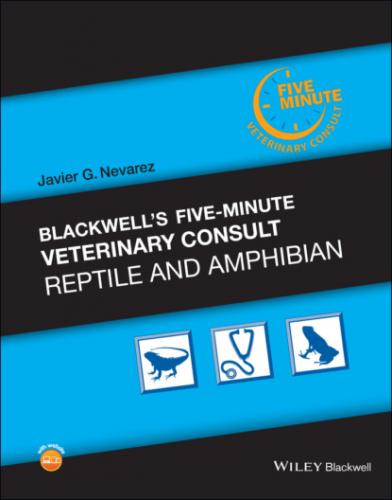SIGNALMENT/HISTORY
More common in terrestrial species with a history of husbandry or diet deficits.
Sometimes may have been previously treated with potentially nephrotoxic drugs.
CLINICAL PRESENTATION
Animals with articular or periarticular gout usually present with obvious joint swellings.
One or more joints may be affected, and the animal may be lame.
Animals with visceral gout may be asymptomatic or may have non‐specific signs such as lethargy and reduced appetite.
Sometimes white nodules may be visualized on examination of the oral cavity or subcutaneously.
RISK FACTORS
Husbandry
Inappropriate environmental temperatures
Inappropriate water provision (e.g., low humidity or fresh water not supplied in an easily accessible way)
High‐protein diets
Others
Administration of potentially nephrotoxic drugs (e.g., aminoglycosides), especially to dehydrated patients.
Gout may be suspected on history and clinical examination, but diagnostic testing will be necessary for definitive diagnosis.
DIFFERENTIAL DIAGNOSIS
For articular swellings, differentials include pseudogout, septic arthritis, trauma, and metabolic bone diseases.
DIAGNOSTICS
Cytologic examination of aspirates from affected joints for articular or periarticular gout. For visceral gout, biopsies need to be taken for histopathology.
Demonstration of uric acid (usually monosodium urate) crystals is necessary for definitive diagnosis.
Blood uric acid levels may be elevated, but this is not always a consistent finding as this depends on the stage in the disease process.
On radiography of affected limbs, lytic lesions may be seen in and around joints. Crystals are radiolucent so will not be detected.
Ultrasound of the coelomic organs may reveal echodense areas of precipitates within internal organs in cases of visceral gout.
PATHOLOGICAL FINDINGS
On gross postmortem examination, small white nodules (tophi) can be seen scattered throughout visceral organs, within or around joints.
On histopathological examination, tophi are often surrounded by granulomatous inflammation.
APPROPRIATE HEALTH CARE
Treatment aims to lower blood uric acid levels and promote uric acid excretion.
Supportive treatment should always include appropriate analgesia, as in other species this is known to be a painful condition.
Euthanasia may be considered in severe cases.
NUTRITIONAL SUPPORT
Some patients may be anorexic and severely dehydrated on presentation.
Fluid deficits should always be corrected, and nutritional support provided.
Care should be taken to provide an appropriate diet low in dietary purines to minimize further uric acid production.
CLIENT EDUCATION/HUSBANDRY RECOMMENDATIONS
Husbandry should be reviewed to identify any predisposing factors, such as inappropriate temperatures or low humidity, and these should be corrected.
Clean fresh water should always be available in a recognizable form for the species.
Diet should be reviewed to ensure that it is appropriate for the species and not too high in protein.
Clients should be advised that this is a condition that will require long‐term management and can potentially be very painful if allowed to progress.
SURGICAL CONSIDERATIONS
Surgical removal of tophi may be considered if only one joint is affected, but permanent damage to the joint may already have occurred.
DRUG(S) OF CHOICE
Allopurinol is the most common choice for treating gout. It is a xanthine oxidase‐inhibiting drug that works by inhibiting the conversion of hypoxanthine and xanthine to uric acid in the liver, consequently reducing blood uric acid levels.
If blood uric acid levels remain consistently low, existing deposits may potentially dissolve.
Doses of 10–20 mg/kg PO q24h are recommended for most species.
Long‐term medication will be necessary to prevent relapses.
Other drugs to promote uric acid excretion such as probenecid can theoretically be used but are contraindicated in dehydrated patients.
In cases of visceral gout, allopurinol should also be avoided as it increases uric acid excretion by the kidneys and could theoretically make the condition worse.
PRECAUTIONS/INTERACTIONS
Allopurinol and probenecid may potentially interact, although the clinical significance of this interaction in reptiles is unknown.
PATIENT MONITORING
Response to therapy is usually monitored by physical examination findings (e.g., increase in activity levels or no progression in joint swellings).
Repeat blood samples can also be taken to recheck uric acid levels which would be expected to start reducing within 7 days of allopurinol treatment.
EXPECTED COURSE AND PROGNOSIS
The prognosis for patients with severe widespread disease is poor, but if diagnosed early the condition could be managed successfully.
If left untreated, the disease will progress with widespread uric acid deposition ultimately resulting in organ failure and death.
